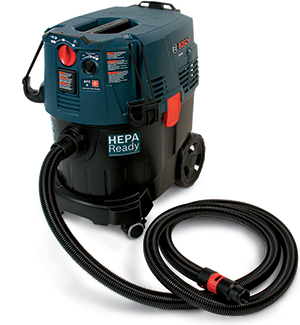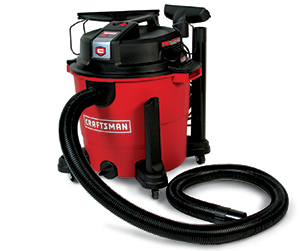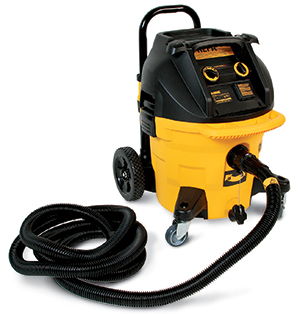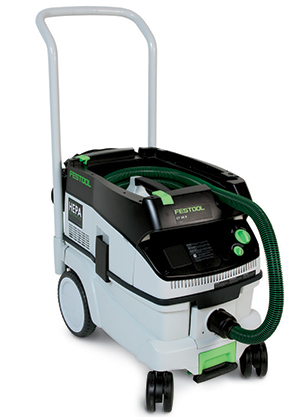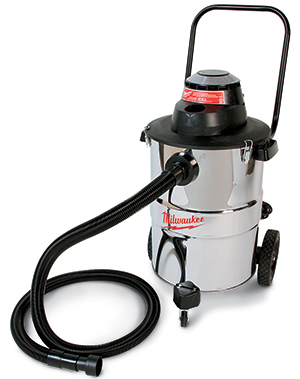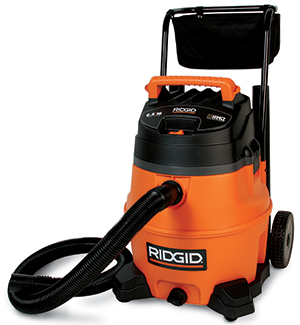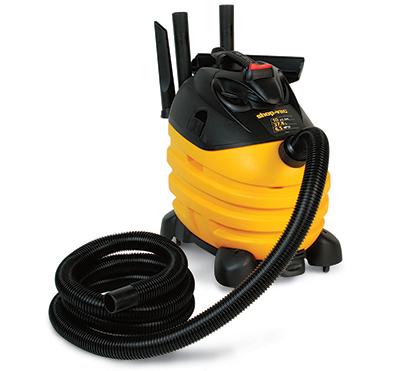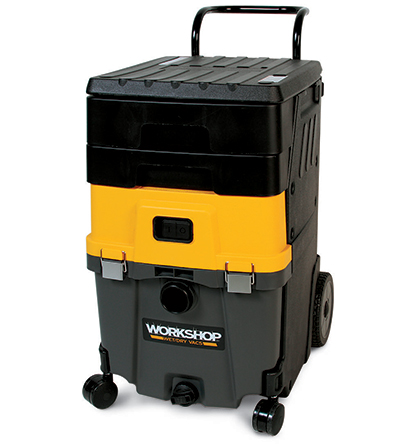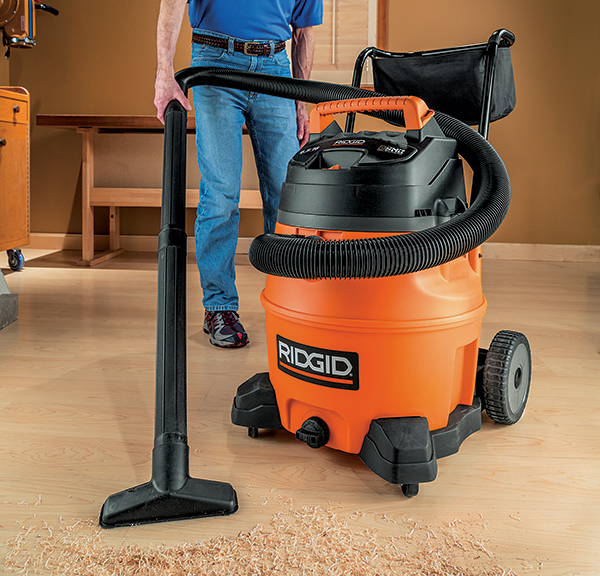
Design and engineering details make each of these shop vacuums unique.
Like all dedicated woodworkers, I have no problem generating copious amounts of dust and debris. And while making dust is always more fun than cleaning it up, cleaning doesn’t need to be an onerous task. With new shop vacuums, even the most basic models are quite capable, making the dreaded cleanup job much more convenient, effective and enjoyable. Efficient filters and well-sealed tanks are standard with most current models, and design and engineering advances have resulted in vacuums that fit the needs and budget of almost every woodworker and DIYer.
A Model for Every Need
I evaluated eight shop vacuums, from very affordable general-purpose models to high-end dust extractors for professionals and serious (and well-heeled) woodworkers. Whether you need to clean your shop floor, extract dust from a power sander or suck up a small flood in your basement, one of these units has you covered.
For simplicity, I’ve sorted the featured models into three categories: value-priced general-purpose vacuums, step-up general purpose vacuums, and commercial-duty dust extractors. Because each model is designed for a specific mar- ket niche and to provide the appropriate set of features, a head-to-head comparison isn’t really meaningful — it would be like trying to compare se- dans, sports cars and SUVs.
I found that all of the tested vacuums provide more than adequate suction for their intended use. Almost any vacuum will suffer a decrease in performance as it fills with debris, and the finer the dust particles, the more rapid the decline.
Hose diameters and lengths vary considerably, but the short explanation is that a larger-diameter hose moves more air and is good for picking up bigger objects, while a smaller hose increases air velocity and is better for sucking up dust. A long hose gives you more reach for cleaning or collecting dust from a tool without having to move the vacuum.
Most of the vacuums come with a standard-duty pleated filter, but other choices are available, such as filters for heavy-duty applications and HEPA (high-efficiency particle air) filters that trap microscopic dust. Note that installing a HEPA filter does not necessarily mean a vacuum is certified for hazardous material mitigation. The type of filter installed will also have an impact on the vacuum’s performance, depending on its airflow resistance.
Models with cylindrical filters that extend into the canister will suffer most quickly as the canister fills and the filter becomes submerged in dust and debris. Empty these vacuums early and often to maintain performance. Also, cleaning or replacing the filter regularly will help maintain peak performance and extend the life of the motor.
The three dust extractors have an auto-on feature that’s triggered by a power tool plugged into it. They also have variable suction control, which allows you to dial in the right amount of power for the tool
in use (prevents sanders from sticking to the work, etc.).
There are many other details to consider, such as cord, hose and accessory storage, the accessibility of the power switch and how convenient the motor housing latches are to use.
Bosch VAC090A
The Bosch is a sturdily built professional-level dust extractor, priced at $600, with many well-implemented features. Like the others in this category, it has variable suction control and an auto-on power tool outlet. There’s a very convenient hinged filter-access lid on top, and the 11⁄4″ x almost 10′ hose attaches to the front port with a twist lock and stores easily with bungee-style straps. Another useful feature is the retaining system for Bosch’s L-Boxx tool and storage boxes, which turns the vacuum into a handy dolly. There’s an automatic filter cleaning feature that makes a loud thumping noise every 15 seconds — it’s a feature, not a problem. However, auto-clean must be turned off when using paper collection bags or a HEPA filter. The Bosch’s narrow, snag-free design makes it easy to use in close quarters.
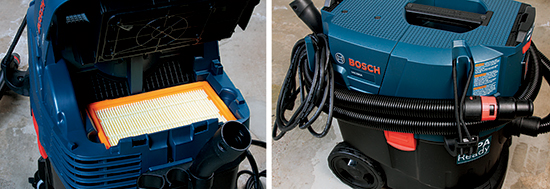
Craftsman 125.12007
This Craftsman general-purpose shop vacuum delivers a lot of value for the money. Priced at $100, it generates remarkably strong suction, and it has good build quality and an extensive selection of cleaning tools. The onboard storage has a place for everything, and the motor unit’s flat top makes a good tray for holding tools and small objects. A simple twist lock secures the 21⁄2″ (x 7′) hose to both the inlet and blower ports.
Because it’s one of the larger units, it might be a challenge to use in a small shop. It also requires some quick and easy assembly. I found the canister latches to be a little balky to use, and it wasn’t always clear when or if they engaged properly.

DeWALT DWV012
Among the dust extractors, the DeWALT, which costs $500, is a relative bargain. It’s solidly built with high quality materials, and it’s impressively powerful. A lot of attention has been paid to ergonomics. Three handles are provided for wrangling the unit, as well as a rear telescoping handle. The canister latches are large and easy to use, and it has convenient hose and cord storage. A ball-bearing twist lock keeps the 11⁄4″ x 15′ hose securely attached to the inlet port. This vacuum also has an automatic filter cleaner, which clicks loudly about every 30 seconds. The canister accepts accessory paper and fleece filter bags but can be used without them. You can employ this vacuum for any cleaning task, but DeWALT is quick to point out that it’s primarily a dust extractor. And like all the other dust extractors, no accessories are included.
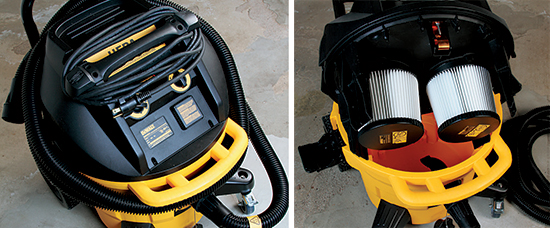
Festool CT 26
From its performance to its price of $625, the Festool leaves no doubt that it’s a premium dust extractor. This is a system vacuum that’s compatible with almost all of the company’s power tools — and other brands — and offers a mind-boggling array of accessories. The CT 26 uses a self-cleaning filter bag to maintain its strong performance, and it has a well-designed hose and cord garage on the top as well as a cord wrap on the back. Other nice touches include a standard 11⁄16″ x 111⁄2′ anti-static hose and a brake to prevent unwanted movement. I found it to be noticeably quieter than the other models, and its rectangular footprint allows it to maneuver easily in tight quarters. The vacuum can also be used as a mobile cart for Systainer® tool and storage boxes. For more capacity, Festool offers the CT 36 and CT 48 models with larger canisters.
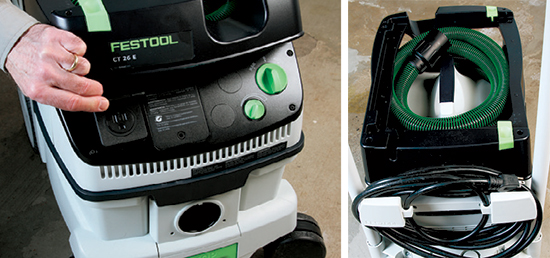
Milwaukee 8955
The Milwaukee is a step-up general purpose vacuum that’s old school, but in a good way. It may look like it’s from the middle of the last century, but its motor and filtration are thoroughly modern. It provides plenty of suction and, because the canister is tall, it can collect a lot of debris below the filter before it needs to be emptied. I found the two-wheel, one-caster dolly arrangement to be easy to maneuver, but not quite as stable as models with four contact points. The power switch is small and hard to see on the back of the motor. I think it should be “Milwaukee red” to at least make it more visible. Unfortunately, there are no cleaning tools included with this model. With its steel tank and simple construction, this vacuum, with its 11⁄2″ x 7′ hose and price of $270, is a workhorse that should last for many years.
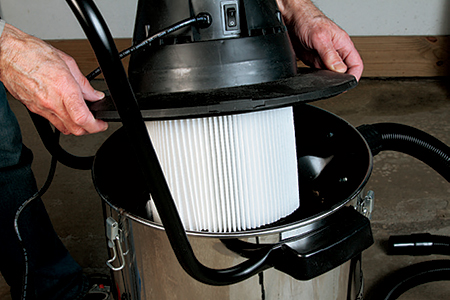
RIDGID WD1851
The RIDGID seems to get all the details right. It’s a step-up general purpose model that’s feature-rich and easy on the pocketbook with its price of $159. Despite its strong performance, it’s relatively quiet, due in part to the included muffler. There’s a good selection of standard-issue cleaning tools that all fit in the non-fussy fabric tool caddy mounted on the handle. Large wheels and casters provide the unit with excellent mobility over rough surfaces. Additional features including a 21⁄2″ x 7′ locking hose, a bottom-mounted drain for wet pickup and secure canister latching make this a very pleasant vacuum to operate. Some assembly is required, but it doesn’t take long and the parts fit well. This is a nicely made vacuum that has few, if any, disadvantages.
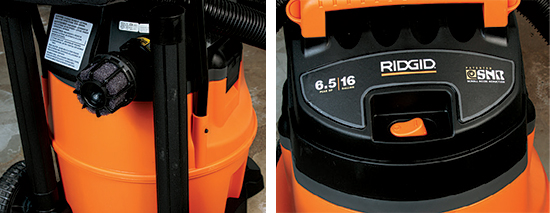
Shop Vac 5873410
The Shop Vac is a general- purpose model and the most compact model in this group. It’s versatile and excels in the mobility department. I grew to like this vac because it’s a very good performer that’s easy to use anywhere. Priced at $130, it also comes with a generous selection of cleaning tools and even a paper filter bag for collecting fine dust from drywall and concrete. A 11⁄2″ x 12′ hose with a screw lock gives this vacuum more reach than any of the other general-purpose models. The dolly can be removed quickly by pressing a lever, so the vacuum can be converted for handheld use. If space is at a premium and you want a vacuum that’s easy to use anywhere in your home, this is a great choice.

WORKSHOP WS1100CA0
If you’re the super-organized type, you’ll love the WORK- SHOP vacuum. With a price of $250, it’s a general-purpose step-up model that’s designed like a rolling toolbox. There are two slide-out compartments (the top compartment also has a lid) that store the 17⁄8″ x 8′ hose and cleaning tools with motor, filter and canister positioned below them. There’s even a shelf on the back for storing cleaning supplies. Aside from its sleek, functional design this vacuum is a great performer and a very quiet one, too. Other features include a rear-wheel brake to keep the unit stationary, a cord wrap and a locking hose. It’s easy enough to roll the unit but it’s very heavy, so lifting it is a chore. The WORKSHOP seems to be a durable, well- made machine that should provide years of service.
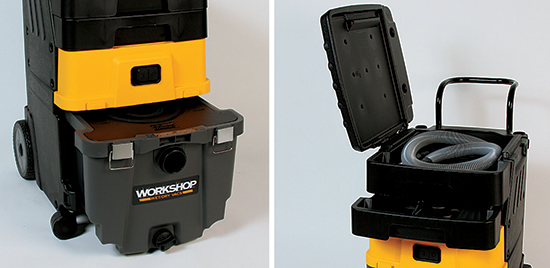
Sound and Size
Earlier, I gave you a heads-up on filter and hose size details you should consider in your search for the right shop vacuum. Sound and size are also important considerations.
Although several manufacturers list the decibel level of their vacuums, how and where the measurement is taken makes a difference, as does the frequency of the sound. Fortunately, none of the vacuums were uncomfortably loud, but I’d still recommend wearing hearing protection.
Finally, unless you intend to use your shop vacuum as a stationary dust collector, you should consider the size of its footprint, its dolly and how the accessories, cord and hose are stored. Large casters and wheels will ease travel over rough and uneven surfaces, and a handle will make maneuvering a vacuum much easier.
